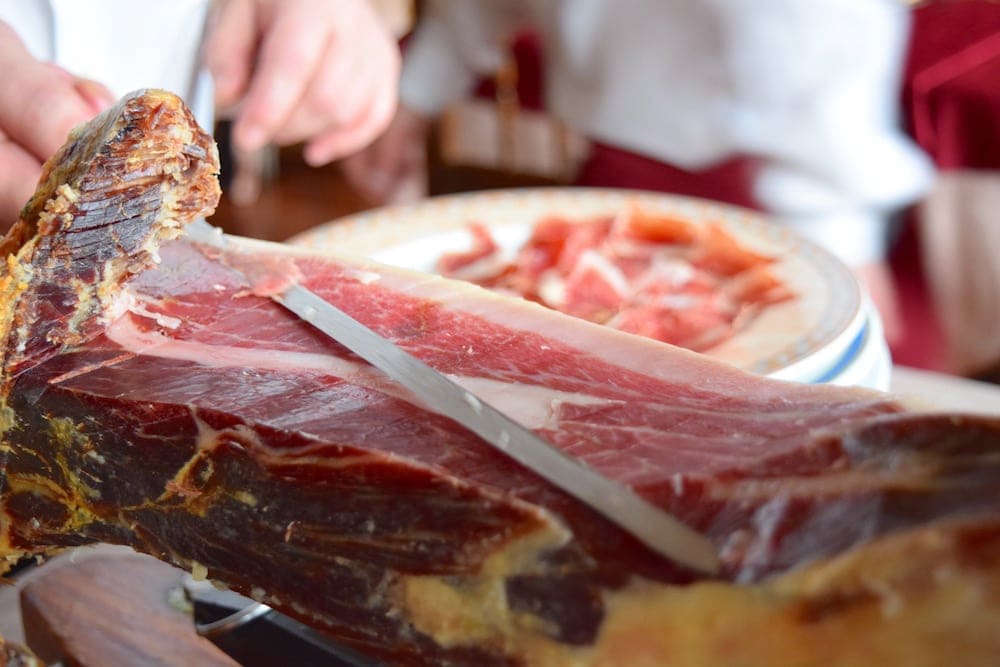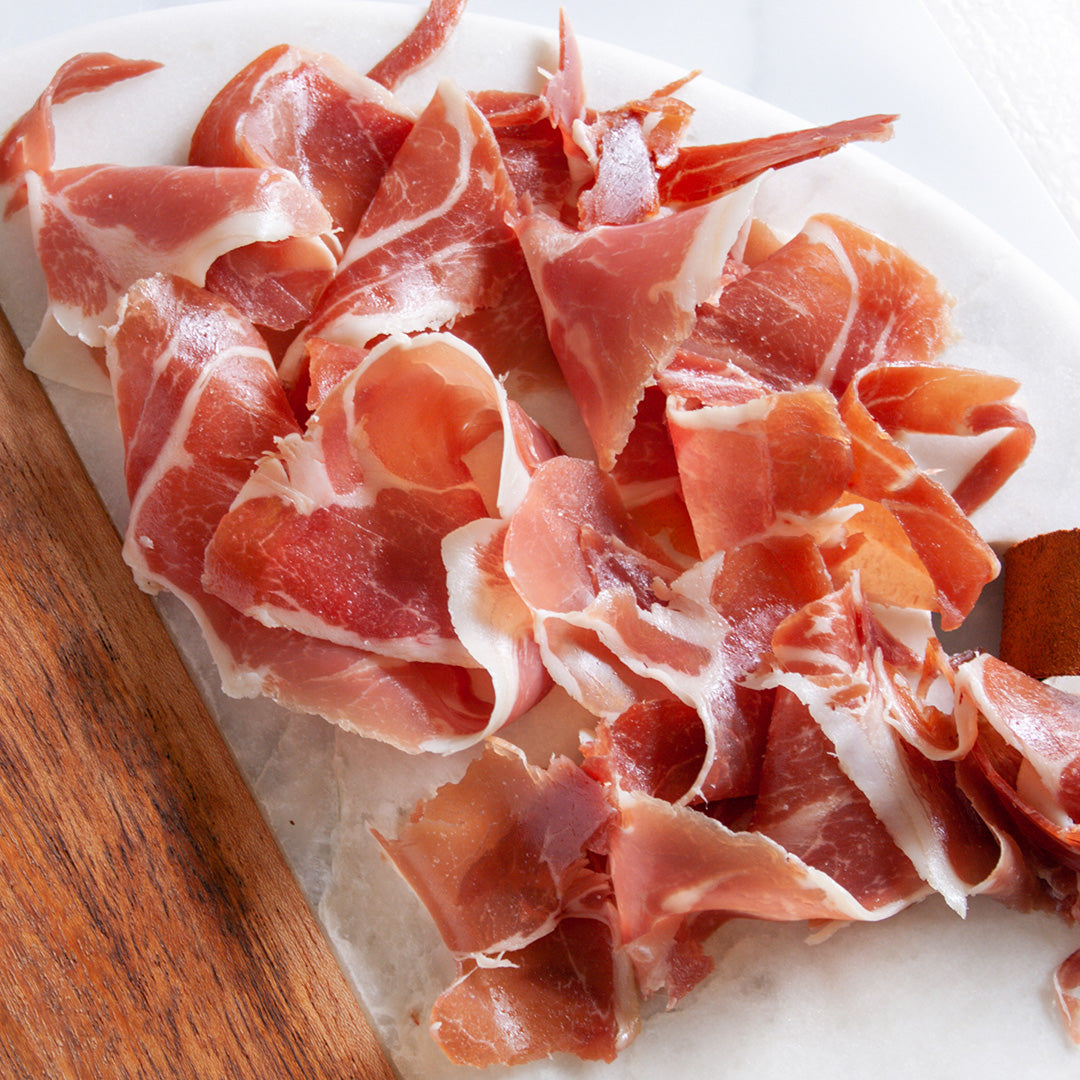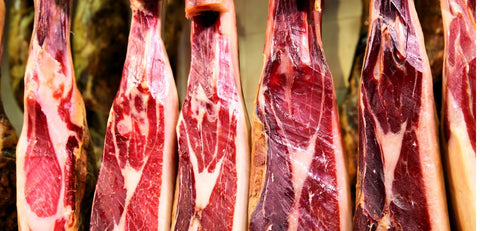Introduction

Spanish cured meats have a rich tradition and are highly regarded in the culinary world. Two of the most prominent varieties are Serrano and Iberico ham. Serrano ham is made from a more common breed of white pig, while Iberico ham is made from the rare and esteemed black Iberian pig. The breed of pig, along with factors such as curing time and diet, all contribute to distinct flavors and textures. This article will explore the production, characteristics, and gastronomic uses of both Serrano and Iberico ham, allowing readers to understand and appreciate the differences between these Spanish delicacies.
Brief Overview Of Spanish Cured Meats
Spanish cured meats have a long-standing tradition in the culinary world. They are known for their rich flavors and distinct textures. Some of the most popular Spanish cured meats include chorizo, salchichón, lomo, and of course, Serrano and Iberico ham. These meats are meticulously cured and aged to enhance their flavors and develop a unique taste. Each type of cured meat has its own characteristics and uses in Spanish cuisine. Whether enjoyed on their own, in sandwiches, or as part of tapas, Spanish cured meats are a delicious and integral part of the country’s gastronomy.
The Significance Of Serrano And Iberico In Spanish Cuisine
Serrano and Iberico hams hold a significant place in Spanish cuisine. These cured meats are cherished for their distinct flavors and textures, which add depth to a wide range of dishes. They are often used in traditional tapas, sandwiches, and charcuterie boards, showcasing the culinary diversity of Spain. Serrano ham, with its milder flavor, is a versatile ingredient that can be incorporated into various recipes. On the other hand, Iberico ham, with its luxurious marbling and intense flavor, is considered a gourmet delicacy. Both hams are beloved by locals and sought after by food enthusiasts worldwide, making them an essential part of Spanish gastronomy.
Serrano Ham

Production process and characteristics:
Serrano ham, also known as Jamón Serrano, is a traditional Spanish cured meat made from the meat of white pigs. The production process involves salting the meat and then allowing it to dry and age for a period of time, usually between 9 to 18 months. This curing process gives Serrano ham its distinctive flavor and texture.
Flavor profile and gastronomic uses:
Serrano ham has a milder flavor compared to its counterpart, Iberico ham. It is characterized by its delicate and slightly salty taste, with hints of nuttiness. The texture is firm and slightly chewy, making it ideal for slicing and serving as part of a charcuterie board, sandwiches, or traditional Spanish tapas. Serrano ham adds depth and richness to a variety of dishes, enhancing the overall flavor profile.
Serrano Ham: Production Process And Characteristics
The production process of Serrano ham involves salting the meat of white pigs and allowing it to dry and age for approximately 9 to 18 months. During this time, the ham develops its distinct flavor and texture. Serrano ham is known for its milder taste compared to Iberico ham, with a delicate and slightly salty flavor, complemented by hints of nuttiness. The texture of Serrano ham is firm and slightly chewy, making it perfect for slicing and serving as part of a charcuterie board or in traditional Spanish tapas. It adds depth and richness to a variety of dishes.
Serrano Ham: Flavor Profile And Gastronomic Uses
Serrano ham boasts a delicate and slightly salty flavor with hints of nuttiness. Its texture is firm and slightly chewy, making it ideal for slicing and serving as part of a charcuterie board or in traditional Spanish tapas. The milder taste of Serrano ham compared to Iberico ham allows it to complement a variety of dishes without overpowering them. From sandwiches and salads to pasta dishes and omelettes, Serrano ham adds depth and richness to any gastronomic creation. Its versatility makes it a beloved ingredient in Spanish cuisine.
Iberico Ham

Iberico ham, also known as Jamón Ibérico, holds a special place in Spanish cuisine. This esteemed cured meat comes from the black Iberian pig, a rare and premium breed that is only found in certain regions of Spain. The production process of Iberico ham involves a careful and lengthy curing period, which can range from 24 to 48 months. The result is a complex and flavorful meat with a unique nutty and slightly sweet taste. Iberico ham is highly regarded for its marbling and rich, melt-in-your-mouth texture. Its distinct qualities and exquisite taste make it a prized delicacy enjoyed by many.
Iberico Ham: Grades And Classifications
Iberico ham is classified into different grades based on the purity of the Iberian pig breed and the pigs’ diet. The highest grade is Jamón Ibérico de Bellota, which comes from acorn-fed Iberian pigs and has the best flavor and texture. The next grade is Jamón Ibérico de Recebo, made from pigs fed a combination of acorns and other feed. Lastly, there is Jamón Ibérico de Cebo, made from pigs fed on commercial feed. Each grade has its own distinct qualities and price point, allowing consumers to choose the level of richness and complexity they prefer.
Iberico Ham: Unique Qualities And Taste Distinctions
Iberico ham has unique qualities that set it apart from other cured meats. Its distinct marbling of fat gives it a rich and buttery texture, while the long curing process enhances its flavor. The meat from acorn-fed Iberian pigs is known for its sweet and nutty taste, with hints of grass and wild herbs. The intense aroma and complexity of flavors make Iberico ham a delicacy and a favorite among food enthusiasts. The combination of the pigs’ breed, diet, and curing process creates a truly exceptional and sought-after product.
Serrano Vs Iberico: A Comparative Analysis

When it comes to comparing Serrano and Iberico ham, there are several key differences to consider. Firstly, the breed of pig used sets them apart, with Serrano ham coming from a more common white pig and Iberico ham being sourced from the rare and exclusive black Iberian pig. Additionally, the pigs’ diet plays a significant role in the flavor of the meat, with Iberico pigs being fed a diet of acorns and grass, resulting in a richer and more distinct taste. In terms of nutritional value, Iberico ham contains higher levels of healthy monounsaturated fats compared to Serrano ham. Both hams have their own unique qualities and are highly regarded in Spanish cuisine.
Varieties Of Serrano Vs Iberico
When it comes to varieties, Serrano ham is available in different grades based on the pig’s diet and curing process. The most common varieties are Jamón Serrano Reserva and Jamón Serrano Gran Reserva. On the other hand, Iberico ham has a more extensive range of varieties. The highest quality is Jamón Iberico de Bellota, which is made from acorn-fed pigs and aged for a minimum of 36 months. Other varieties include Jamón Iberico de Cebo de Campo and Jamón Iberico de Cebo, which are made from pigs fed with a mixture of acorns and grains. Each variety offers a unique taste and texture.
Nutritional Differences And Health Benefits
When comparing the nutritional differences between Serrano and Iberico ham, it is important to consider the fat content. Serrano ham tends to have less fat compared to Iberico ham, making it a slightly leaner option. However, Iberico ham contains higher levels of mono and polyunsaturated fats, which are known to be heart-healthy fats. Both hams provide a good source of protein, vitamins, and minerals. Additionally, the curing process of these meats enhances their flavor while preserving essential nutrients. Incorporating moderate amounts of Serrano or Iberico ham into a balanced diet can offer a delicious and nutrient-dense addition.
Serving And Pairing

Serving and Pairing: When it comes to serving Serrano and Iberico ham, it is best to slice the meat thinly and serve it at room temperature to fully enjoy its flavors and texture. Serrano ham goes well with bread, olives, and cheeses like Manchego. Iberico ham pairs beautifully with melon, figs, and almonds. To enhance the experience, consider serving these hams on a wooden board or platter. As for wine and cheese pairings, a dry white wine or a tannic red wine complements the rich and salty flavors of both Serrano and Iberico ham. Don’t forget to explore the world of Spanish cured meats and delicacies beyond ham, such as chorizo or lomo, to create a diverse and delightful spread.
Best Practices For Serving Serrano And Iberico
To fully enjoy the flavors and textures of Serrano and Iberico ham, it is recommended to slice the meat thinly and serve it at room temperature. Serrano ham pairs well with bread, olives, and cheeses like Manchego, while Iberico ham pairs beautifully with melon, figs, and almonds. To enhance the presentation, consider serving these hams on a wooden board or platter. When it comes to wine and cheese pairings, a dry white wine or a tannic red wine complements the rich and salty flavors of both Serrano and Iberico ham. Exploring the world of Spanish cured meats beyond ham, such as chorizo or lomo, can also provide a diverse and delightful spread.
Wine And Cheese Pairings With Spanish Cured Meats
When it comes to enjoying Spanish cured meats like Serrano and Iberico ham, pairing them with the right wine and cheese can elevate the flavors even further. For Serrano ham, it is often paired with a dry white wine, such as Verdejo or Albariño, which complements its delicate flavors. Manchego cheese is a popular choice to accompany Serrano ham, as its nutty and slightly tangy profile enhances the overall experience. On the other hand, Iberico ham pairs beautifully with a tannic red wine, like Tempranillo or Rioja, which complements its rich and complex flavors. For cheese, a creamy and mild cheese, such as Mahón or Tetilla, works well with the intense flavor of Iberico ham. Whether you choose Serrano or Iberico ham, and whether you prefer white or red wine, the combination of Spanish cured meats with carefully chosen wines and cheeses is sure to be a delightful culinary experience.
Conclusion

In conclusion, exploring the world of Spanish cured meats, particularly Serrano and Iberico ham, is a journey filled with rich flavors and unique characteristics. Serrano ham, with its delicate and slightly salty taste, pairs beautifully with dry white wines and nutty Manchego cheese. On the other hand, the rich and complex flavors of Iberico ham are best complemented by tannic red wines and creamy Mahón cheese. Regardless of your preference, both Serrano and Iberico ham offer a culinary experience that showcases the rich tradition and craftsmanship of Spanish cuisine. So, indulge in these delectable cured meats and savor the true taste of Spain.
Preferences And Recommendations For Serrano And Iberico
When it comes to preferences and recommendations for Serrano and Iberico ham, it ultimately comes down to personal taste. Some individuals prefer the delicate and slightly salty flavor of Serrano ham, while others favor the rich and complex taste of Iberico ham.
However, if you’re new to Spanish cured meats, it is recommended to start with Serrano ham as it offers a milder flavor profile that is more widely accessible. As you develop your palate, you can then explore the unique and luxurious qualities of Iberico ham.
To truly appreciate the flavors of both Serrano and Iberico ham, it is best to enjoy them thinly sliced and at room temperature. Pair them with traditional accompaniments such as crusty bread, olives, and tomatoes for a classic Spanish experience.
Exploring Other Spanish Cured Meats And Delicacies
In addition to Serrano and Iberico ham, Spain offers a wide range of other delicious cured meats and delicacies. Chorizo, a spicy and flavorful sausage made from pork, paprika, and garlic, is a popular choice. Another popular cured meat is lomo, which is made from pork tenderloin and seasoned with spices. Other Spanish delicacies include morcilla (blood sausage), salchichón (a cured sausage similar to salami), and fuet (a thin, dried sausage). These cured meats are often enjoyed on their own, in sandwiches, or as part of tapas spreads. Exploring these varieties can provide a deeper appreciation for Spanish cuisine.
FAQ About Serrano Vs Iberico: Exploring Spanish Cured Meats
Q: What is the main difference between Serrano and Iberico ham?
A: The main difference lies in the type of pigs used. Serrano ham comes from white pigs, while Iberico ham comes from Iberian pigs, known for their unique flavor and marbling.
Q: How does the taste of Serrano ham compare to Iberico ham?
A: Serrano ham has a milder flavor compared to the richer, nuttier taste of Iberico ham. The acorn-fed Iberico ham is considered a gourmet delicacy with a more intense flavor profile.
Q: Are there variations in the curing process between Serrano and Iberico ham?
A: Yes, there are differences in the curing process. Iberico ham undergoes a longer curing period, often up to 36 months, compared to Serrano ham, which typically cures for around 12 to 18 months.
Q: How can one distinguish between Serrano and Iberico ham when purchasing?
A: Look for the differences in the labeling. Iberico ham is usually labeled based on the pig’s breed and diet, such as “Bellota” for acorn-fed Iberico ham, while Serrano ham may mention the pig’s breed as “white pig.”
Q: Which one is considered more premium – Serrano or Iberico ham?
A: Iberico ham is generally considered more premium due to the rarity of Iberian pigs, their unique diet, and the longer curing process. However, Serrano ham remains a popular and flavorful option for those looking for a more accessible Spanish cured meat.
Q: Can Serrano and Iberico ham be used interchangeably in recipes?
A: While both hams are delicious cured meats, their flavor profiles are distinct. It’s best to use Serrano ham in recipes that call for its milder taste and Iberico ham for dishes where the richer, nuttier flavor can shine.

Hot Pot Chinese Restaurant, located in Mechanicsville, MD 20659, is a culinary destination that offers a delightful array of Chinese cuisine. From the cozy ambiance to the delectable dishes, Hot Pot Chinese Restaurant is dedicated to providing an exceptional dining experience for all patrons. Since our establishment, Hot Pot Chinese Restaurant has been committed to serving the finest Chinese food, offering a diverse menu that caters to a wide range of tastes. Whether you’re craving traditional favorites like Kung Pao Chicken and Mongolian Beef or seeking out more adventurous options like Szechuan Spicy Hot Pot, our menu has something to satisfy every craving.